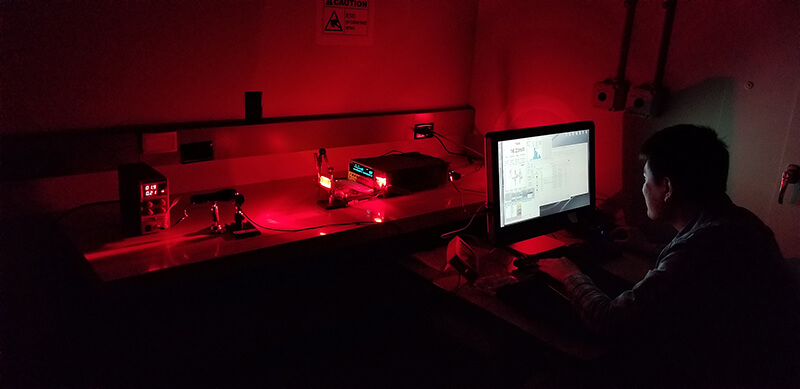September 27, 2018
Light it up: Purdue NSF-funded technology flips the switch on the future for sustainable smart homes and $1.3 trillion market
 Purdue University graduate student Xiaozhe Fan measures how much light is emitted by a GaAs solar cell. The light emitted by the solar cell is modulated to convey information. (Image provided)
Download image
Purdue University graduate student Xiaozhe Fan measures how much light is emitted by a GaAs solar cell. The light emitted by the solar cell is modulated to convey information. (Image provided)
Download image
WEST LAFAYETTE, Ind. – The smart home of today takes walls full of wiring.
The smart home of tomorrow will be wireless.
Thanks to new, patented Purdue University technology being funded by the National Science Foundation, the answer may be as simple as turning on the light.
Purdue University researchers have patented a technology taking advantage of the Internet of Things solutions, which have been growing at an astonishing pace. The growth is expected to amount to a $1.3 trillion market opportunity in areas such as consumer electronics and health.
IoT devices need a wireless means of communications to be truly seamless so they can be easily integrated in everyday objects and harvest energy from their environments to avoid frequent recharging, said researcher Walter Daniel Leon-Salas.
“We created a revolutionary way to use light to power these devices, “ said Leon-Salas, an associate professor in Purdue’s School of Engineering Technology, who led the research team. “Light energy is the most available form of ambient energy, with much higher energy density levels than radio-frequency or mechanical ambient energy sources.”
The technology appears in the latest edition of IEEE Transactions on Circuits and Systems I.
The technology aligns with Purdue's Giant Leaps celebration of the university’s global advancements made in health, space, artificial intelligence and sustainability as part of Purdue’s 150th anniversary. Those are the four themes of the yearlong celebration’s Ideas Festival, designed to showcase Purdue as an intellectual center solving real-world issues. Such solutions, including smart technology is a focus of Purdue’s Discovery Park District.
The Purdue system, which received a $450,000 NSF grant, uses solar cells as optical antennas to transmit and receive information wirelessly between various devices. The light that activates the solar cells may come from ambient light or from a reader that actively illuminates the solar cell.
“The current radio-frequency energy systems make it nearly impossible for a homeowner to tell where signals are coming from,” Leon-Salas said. “Those signals are very difficult to trace back to the original sending location. Our light system makes it very easy since light is easy to trace back to a source. It’s kind of like when you take a picture with a camera, you can tell from the photo where the camera was located in relation to the objects being photographed.”
Purdue’s system would allow a user to easily connect many different kinds of electronic devices across a home. The technology also works with a backup battery for when light is not available.
Researchers worked with the Purdue Office of Technology Commercialization to secure a patent for the technology. It is available for licensing.
About Purdue Office of Technology Commercialization
The Purdue Office of Technology Commercialization operates one of the most comprehensive technology transfer programs among leading research universities in the U.S. Services provided by this office support the economic development initiatives of Purdue University and benefit the university's academic activities. The office is managed by the Purdue Research Foundation, which received the 2016 Innovation and Economic Prosperity Universities Award for Innovation from the Association of Public and Land-grant Universities. For more information about funding and investment opportunities in startups based on a Purdue innovation, contact the Purdue Foundry at foundry@prf.org. For more information on licensing a Purdue innovation, contact the Office of Technology Commercialization at otcip@prf.org. The Purdue Research Foundation is a private, nonprofit foundation created to advance the mission of Purdue University.
Writer: Chris Adam, 765-588-3341, cladam@prf.org
Source: Walter Daniel Leon-Salas, wleonsal@purdue.edu
ABSTRACT
Solar Cell Photo-Luminescence Modulation for Optical Frequency Identification Devices
Walter Daniel Leon-Salas, Xiaozhe Fan
Purdue University, West Lafayette, IN, USA
doi: 10.1109/TCSI.2018.2867445
This paper presents a wireless optical communication scheme that uses solar cells to transmit information. Transmission of information with a solar cell is possible by exploiting the fact that high-efficiency solar cells are also good at emitting light. These emissions, called luminescent emissions, are a function of the voltage across the cell. Here, we take the advantage of this fact to modulate the luminescent emissions of a GaAs solar cell to transmit information. We call devices that use this type of communication optical frequency identification devices. A circuit model of a solar cell that includes luminescent emissions is presented along with a circuit that modulates the photo-luminescent radiation emitted by a solar cell while harvesting energy from it. An analysis of this circuit is presented and employed to suggest different modulation strategies. A prototype of the modulator was built and tested. Test results show good agreement with the circuit analysis. It is also shown how the proposed circuit can be used to implement pulse amplitude modulation and ON-OFF keying modulation. Experimental results show that the proposed communication system achieves a bit error rate of 1.6×10⁻³ at a rate of 10 kb/s and at a distance of 50 cm.

